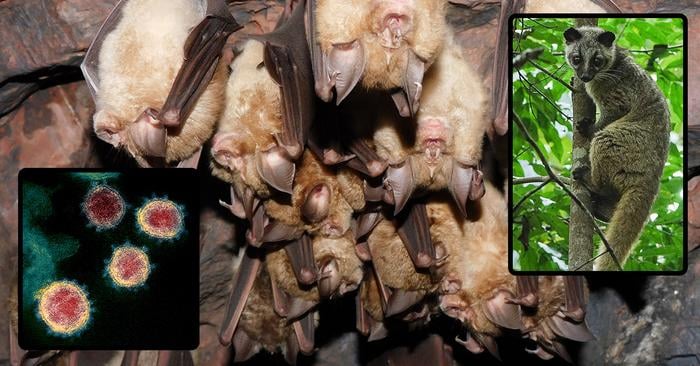A new study published in Cell on May 7, 2025, suggests that the virus behind COVID-19 traveled too quickly from its origin to have been carried naturally by bats. Instead, researchers conclude that the wildlife trade likely transported SARS-CoV-2 to Wuhan, mirroring the path taken by the virus responsible for the 2002 SARS outbreak.
Tracking Viral Movement Through Evolutionary History
Researchers from UC San Diego and several international institutions analyzed the evolutionary history of both SARS-CoV-1 and SARS-CoV-2 by examining genome sequence data. Their analysis faced a key challenge: these viruses frequently recombine inside their hosts, making their evolutionary paths difficult to trace.
“When two different viruses infect the same bat, sometimes what comes out of that bat is an amalgam of different pieces of both viruses,” said Joel Wertheim, Ph.D., professor at UC San Diego School of Medicine and co-senior author of the study.
The team overcame this obstacle by identifying non-recombining regions of the viral genomes to reconstruct accurate evolutionary histories. Their findings paint a clear picture of how these viruses moved across Asia before jumping to humans.
Geography and Timing Reveal Transportation Patterns
The study identified Western China or Northern Laos as the likely origin point for SARS-CoV-2’s ancestor. From there, the virus would have needed to travel up to 2,700 kilometers to reach Wuhan in Central China, where the COVID-19 pandemic began. Similarly, the ancestor of SARS-CoV-1 traveled from Western China to Guangdong Province before causing the 2002 outbreak.
What makes these findings particularly revealing is the timing. The researchers determined that the ancestor of SARS-CoV-2 left its origin point only 5-7 years before COVID-19 emerged in humans. For SARS-CoV-1, this timeline was even shorter—just 1-2 years.
When comparing these travel patterns with typical bat movement, the researchers found a striking mismatch. While the viruses normally spread through bat populations at a rate consistent with horseshoe bat movements (foraging within 2-3 km of their roosts), the final leg of their journey to human population centers happened much too quickly for natural bat dispersal.
Wildlife Trade as the Missing Link
The researchers concluded that the wildlife trade likely played a crucial role in transporting both viruses to their emergence sites. This matches existing evidence about SARS-CoV-1, which previous studies suggest was carried from Yunnan to Guangdong by infected palm civets or raccoon dogs—animals commonly traded for fur and meat.
“The viruses most closely related to the original SARS coronavirus were found in palm civets and raccoon dogs in southern China, hundreds of miles from the bat populations that were their original source,” explained Michael Worobey, Ph.D., professor at The University of Arizona and co-senior author. “For more than two decades the scientific community has concluded that the live-wildlife trade was how those hundreds of miles were covered. We’re seeing exactly the same pattern with SARS-CoV-2.”
These findings address concerns that had fueled speculation about lab origins for SARS-CoV-2.
“At the outset of the COVID-19 pandemic, there was a concern that the distance between Wuhan and the bat virus reservoir was too extreme for a zoonotic origin,” Wertheim noted. “This paper shows that it isn’t unusual and is, in fact, extremely similar to the emergence of SARS-CoV-1 in 2002.”
Implications for Future Pandemic Prevention
Zoonotic spillover events—where diseases jump from animals to humans—are increasing worldwide due to expanding wildlife trade, urbanization, and habitat destruction. The researchers suggest that continued sampling of wild bat populations could help identify potential sources of future coronavirus outbreaks.
By understanding the evolutionary history and transmission patterns of these viruses, scientists hope to better prepare for and control future disease outbreaks. The study highlights the importance of monitoring wildlife trade networks as potential pathways for emerging infectious diseases.
Key Findings:
- SARS-CoV-2’s ancestor originated in Western China or Northern Laos 5-7 years before the COVID-19 pandemic
- The virus traveled up to 2,700 kilometers to reach Wuhan, too quickly for natural bat dispersal
- SARS-CoV-1 showed a similar pattern, moving from Western China to Guangdong in just 1-2 years
- Sarbecoviruses typically spread at rates matching horseshoe bat movement (2-3 km foraging area)
- The wildlife trade likely transported both viruses via intermediate animal hosts
- The findings support similar natural origins for both SARS-CoV-1 and SARS-CoV-2
If our reporting has informed or inspired you, please consider making a donation. Every contribution, no matter the size, empowers us to continue delivering accurate, engaging, and trustworthy science and medical news. Independent journalism requires time, effort, and resources—your support ensures we can keep uncovering the stories that matter most to you.
Join us in making knowledge accessible and impactful. Thank you for standing with us!

